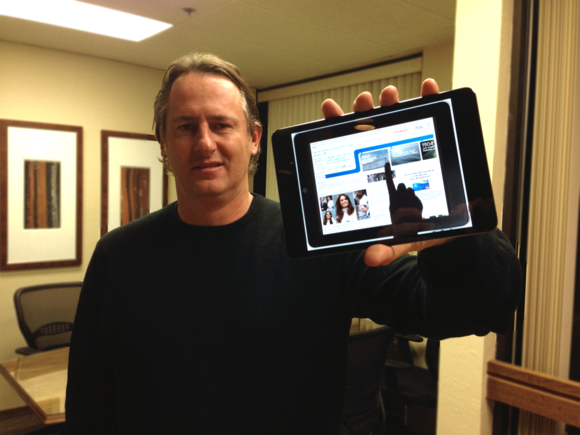Convenience was one reason: The iPad mini has all the capabilities of its bigger predecessor, including wireless AirPlay mirroring that allows him to project the tablet’s screen onto a nearby TV. But salesmanship was a factor, too: There’s nothing like arriving at a meeting, seemingly empty-handed, only to pull the latest and greatest Apple technology from a jacket pocket.
“I pull it out and people are quite astounded,” says Yuill, whose company provides advertising on mobile platforms. “We’re in the business, so we’re promoting the usage as much as we can.”
Months after the iPad mini launched to the public, the device appears to be a hit in the consumer sector, combining with the fourth-generation iPad to sell more than 3 million units in the opening days of the product’s life. But analysts have yet to determine whether the new, miniature tablet will follow its larger iOS predecessors from the living room to the boardroom—and if so, what route it will take to get there.
Schools and hospitals
Two institutions likely to be big iPad mini adopters are schools and hospitals. The first is understandable. Schools already use the iPad, but want to cut down on technology costs. At $329, the iPad mini's starting price is $170 less than that of the iPad with Retina display. Lynn University in Florida will distribute the tablet to first year students next autumn, and the East Jordan, Michigan, school district is buying 770 units of the iPad mini. In the meantime, KinderTown—a developer of educational apps aimed at the 3- to 8-year-old set—saw a dramatic rise in iPad mini usage after the holidays. Inside Higher Ed has endorsed the iPad mini's suitability for classroom use.
But why hospitals? For an unexpected reason: The 7.87-inch-long iPad mini is just the right size to fit in the 8.5-inch-deep pocket of a standard medical lab coat.
“It really fits that lab coat pocket,” says Marianne Braunstein, vice president of product management at Epocrates, which makes medical apps for iOS devices. A survey that her company conducted ahead of the iPad mini launch found that one in three doctors planned to buy the new, smaller tablet.
“They’re moving constantly between exam rooms, around the hospital...they’re very, very mobile people in their careers,” Braunstein says. “They need to have devices that allow them to be very portable.”
The iPad mini might seem to be at a disadvantage in a hospital, since it doesn’t offer the high-resolution Retina display of its bigger counterparts. But Dr. Stephen Ferzoco, chief medical officer at Mobiquity Inc., agrees that doctors will be seeking out the mini: The bigger iPad, he says, is just too cumbersome.
“From a form factor standpoint, doctors can now carry the mini device around in their coat pockets,” he says. “This effectively means that their electronic medical records, order entry, reference materials, and imaging capabilities are within arm's reach at all times.”
Even in hospitals, though, Braunstein expects that doctors will have to bring in the iPad mini themselves, rather than using hospital-issued models.
“For the most part, it’s going to be the individuals,” she says. “These devices make their lives easier, so that’s what they’re going to be bringing into the workplaces.”
The winding path to adoption
Previous iOS devices entered the workplace quickly, but by wildly different routes.
The iPhone, for example, was initially disdained by IT departments that had built their security infrastructure to support the then-dominant Blackberry line of phones from Research in Motion. But the iPhone elbowed its way into the office anyway, initially brought in by top executives and then, increasingly, their underlings—forcing IT departments to adapt. The “bring your own” approach worked for Apple: More than five years later the iPhone is one of the dominant smartphones in the enterprise market.
The iPad, in contrast, was more immediately embraced by institutions—and ended up being distributed in businesses and other workplaces on more of a top-down basis. Within months of its 2010 launch, the tablet was at work in car dealerships, cockpits, and medical schools, as institutions recognized that it could help reduce paperwork and provide more mobility to users than traditional laptop computers.
Analysts say that they expect the iPad mini to follow the iPhone’s trail into the workplace, arriving initially as a BYO device before institutions grasp how to use the small tablet to their advantage.
“I think it’s hard to say it’s going to definitively follow one [route] or the other,” says Frank Gillett, a vice president and principal analyst with Forrester Research in Massachusetts. “The mini, because it’s so small, will follow an individual approach initially—though some businesses will find a smaller, less expensive screen appealing.”
The larger iPad should remain the device of choice for many businesses, Gillett says, since cash register applications such as Square Register and business applications such as SalesForce probably make more sense on the bigger tablet. But in other instances—particularly where device cost is a major factor—the iPad mini has an advantage. It could also prove advantageous in situations where space is at a premium, particularly for users who spend lots of time on planes and in other cramped locations.
“It’s like a lot of other things,” Gillett says. “You pick the right tool for the job.”




